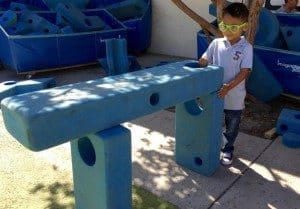Get the Culture Right: The Most Important New School Factor
CompetencyWorks Blog
 This post originally appeared at Getting Smart on June 28, 2016.
This post originally appeared at Getting Smart on June 28, 2016.
“Attend to your culture,” said Jim May who supports about 25 new schools each year for New Tech Network. “From certificates of occupancy to emergency plans to hiring, the list of operational realities that must be addressed when starting a new school is immense. Thus, it can be easy to overlook the importance of your staff and student culture during those early days. However, it is imperative that even amidst the swirl of starting the school that you are intentional about establishing a strong set of cultural norms and rituals that can animate your work in the coming year.”
What’s most important when opening a new school? I asked 20 experts who have collectively opened more than a thousand schools. They shared 70 hard-won lessons and it’s clear that getting the culture right is the single most important factor in the long-term success of a school.
Opening a great school is an enormously complicated project. It involves real estate, construction, financing, logistics and marketing, which most educators don’t initially know anything about.
“Most of us who want to start schools because we like instruction, but the one thing no one tells us is that when you start a school, 90% of what who do early on has nothing to do with instruction,” said Dr. Nicole Assisi, Thrive Public Schools, who has opened five southern California schools.
Andy Calkins, whose Next Generation Learning Challenges has sponsored 100 new schools said, “You will be tempted to immerse yourself in the vast sea of logistical details starting a school entails, to the point of losing sight of the big picture: focusing on orienting your students/families and immediately establishing the culture-building that is so crucial to school and student success. Don’t lose sight of that. Everything else at the start is a detail.”
 “Pay attention to culture,” said Pat DeKlotz, Kettle Moraine School District, who has sponsored four charter schools that operate inside district schools (like KM Global, right). “Listen to students and take the time to nurture the human element. People want identify and purpose. Build that into the culture of your school and you will go far. The processes are important only as long as they bring people along.
“Pay attention to culture,” said Pat DeKlotz, Kettle Moraine School District, who has sponsored four charter schools that operate inside district schools (like KM Global, right). “Listen to students and take the time to nurture the human element. People want identify and purpose. Build that into the culture of your school and you will go far. The processes are important only as long as they bring people along.
If the students are engaged in the learning, they will communicate their success to the parents. A shared vision isn’t shared if it is told. It only becomes shared when people participate in making meaning of it, together, co-creating the work. The “why” of what you are doing needs to permeate each individual involved, students, staff, partners.”
Making the Best of a Bad Situation
More than slogans on the wall or values in a brochure, culture comes down to what you do and say. “Build the culture you want because if you don’t a culture will form and you might not like it,” said Diane Tavenner. “The thing about culture–values, beliefs, behavioral norms, traditions and rituals– is you ALWAYS have to make decisions and behave in alignment, even in the 90 day countdown.”
 “There is no version of launching a new school where something does not go wrong,” said Jim May. When something goes wrong, think of it as a culture-building opportunity, a chance to “strengthen relationships and foster resilience.” (Bulldog Tech in San Jose, right, is part of the New Tech Network.)
“There is no version of launching a new school where something does not go wrong,” said Jim May. When something goes wrong, think of it as a culture-building opportunity, a chance to “strengthen relationships and foster resilience.” (Bulldog Tech in San Jose, right, is part of the New Tech Network.)
If you want a culture that values innovation you need to identify the process that your school will use to manage it. “The most innovative schools succeed because they consistently improve their 1.0 school models,” said Alex Hernandez. “It’s easy for innovation to stop once the kids show up because the team gets overwhelmed with the demands of running a school, particularly when something goes wrong. And, it always will when you’re opening a new school.”
Culture On-Ramp
“Spend quality time on-boarding ALL, not just new teachers–emphasizing a ‘high expectations and whatever it takes’ culture,” said Terry Grier, former Houston ISD superintendent.
“Invest heavily in the orientation experience,” said Jim May. He noted that it is common for new school staffs to benefit from only a couple of hours of orientation before the first day of school. “This represents a monumental opportunity missed. There are very few moments over the course of a school year where you can frame your mission, catalyze the collective energy of your team and set a direction for the school as a whole.”
“If your school is pursuing personalized, next generation learning, teachers need to experience it fully themselves, as learners, before they can enable their students to embrace it,” said Andy Calkins. “Don’t think in terms of hours of PD, think how can we develop, with teachers, a strong culture of on-going professional learning?”
“Think about how to help students acculture themselves to your learning environment,” said Alex Hernandez, Charter School Growth Fund, has supported more than 500 new schools. “Will there be a bootcamp or other introductory experience? How do you want to set the tone around student voice, student agency, joy, etc. To borrow the popular phrase: culture eats strategy for lunch.
 Culture as Precondition for Great Teaching
Culture as Precondition for Great Teaching
“Great teaching and learning is built on a foundation of great culture, so start with culture as a critical path for your teachers, parents and students,” said Mike Feinberg, co-founder of KIPP, a national network of 183 high performing schools.
“Teaching and living the values should be intentional, explicit and full of joy,” said Aaron Brenner of 1 World Network of Schools, a nonprofit sharing lessons from KIPP with communities worldwide (including a school in Israel; see student picture, right). Brenner added:
- Mission Orientation: Ensure everyone on the team is orienting their work around the successful execution of the mission beginning with preparation and organization of the classrooms, planning of an outline for the year, planning of detailed lesson plans for the first month of school, visiting the homes of the children who will attend your school (if that is a component of school start-up which I highly recommend). Every action in those last 90 days should be a reflection of the belief in and commitment to that mission.
- We Watch What We Do To See What We Believe: Beliefs (why) with values as actions (what) with operating norms (how) with artifacts (daily reminders) with the development of character (where). In recruitment of teachers, in personal development of teachers, in training of teachers, there should be an emphasis in the alignment of the school culture. Everything should align and everything should help lead to the achievement of shared beliefs.
- Teaching and Living the Values Should be Intentional, Explicit and Full of Joy: Building on the cultural alignment above, leadership and teachers should plan lessons that teach the values in an explicit, intentional and joyful way. Lesson Planning of Values Lessons should have criteria of success: Rich literature; Integration of Local Community; Integration of Heroes; Opportunity to be Creative through writing, singing, dancing, performing, drawing, painting and/or beyond; a song that connects to the value; specific behaviors/operating norms that the students practice as a reflection of strengthening their living of the values.
- Artifacts Should Celebrate the Mission, Vision and Values of the School: Whether it is classroom doors decorated with a college pennant that are also painted to match the color of the university, the value books blown up to banner size, quotes that align with the values on every door and when you enter the building, symbols of the values throughout the school, and uniforms that celebrate and support the mission and values. This intentionality makes the classrooms, other learning spaces, entrances, play areas and every part of the school come alive.
If you’ve opening a school this fall, Brenner suggests getting away from everything in the middle of the 90 day countdown. “It will give you the space to breathe again, to reflect on what is needed to do in the final 40 days before launch, and the renewed strength to do it.”
Good luck and remember: “Culture eats strategy for breakfast.”
See also:
- Culture and Climate
- 10 Tips for Developing Student Agency
- Engagement Templates: 6 Ways to Structure Learning Experiences
Sydney Schaef, M.BA., M.Ed., is an educator, entrepreneur, and school design consultant. She currently works as a Mastery Learning Designer at reDesign and a design consultant for Building 21. She served at the School District of Philadelphia from 2013-2015 in the Office of New School Models, and prior to that, served as Founder and Executive Director of a 501c3 nonprofit organization that led innovative education and youth development programs in East Africa. Follow Sydney on Twitter at @sydneyschaef.